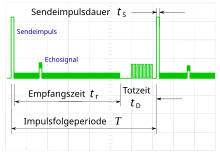Built-in test equipment
Under a Built-In Test Equipment (short BITE , literally "built-in test equipment") refers to additional devices or system components into an overall system which maintenance information and status information as part of built-in test functions to collect and provide opportunities for evaluation and classification of the information. They make it easier to check and monitor the correct functioning of the overall system and in some cases enable BITE to react automatically to problems that arise. The data collected by the BITE are required, among other things, for the upkeep (maintenance) of the overall system; in addition, static evaluations of failures and the early detection of possible problems of individual components can also be carried out.
BITEs are used in safety-critical systems such as avionics to continuously record the condition of an aircraft. The data collected via BITE is used in the area of ongoing aircraft maintenance. Physically, BITE can be implemented as an independent unit that is separated from the rest of the system and queries status information or carries out tests via its own interfaces. Alternatively, it can also be implemented in the overall system as a functionally distributed BITE.
Application examples
Radar system
In a radar system , the transmitter must not be switched on if the antenna test circuits report a malfunction. When the transmitter is working, part of the transmission power is decoupled via directional couplers , rectified and the amplitude of this signal is measured by comparators and the value is sent to the radar data processor. All operating voltages and clock pulses for the radar device are also monitored.
During the operation of the radar device, test signals are fed into the antenna by the BITE during the dead time , which pass through the entire signal processing path from the antenna to the display device and their presence and size are checked at intermediate points such as the receiver output.
If a defective assembly or a missing signal is detected, this information is displayed to the operator on the radar screen. Some radar devices can independently reconfigure the system so that they can continue to work on their core tasks despite the defect.
Avionics
Avionic systems are characterized by a modular structure and as independent a structure as possible, which include certain tasks such as flight control. The subsystems required for this, such as sensors or actuators , the actual electronic flight control unit, displays for the pilot, etc., are referred to in avionics as line replaceable units (LRU). The individual LRUs are connected via defined interfaces and can be exchanged independently. In the simple and conventional case, the LRU of an electronic flight control unit is further divided into the following units in terms of hardware:
- Input and output interfaces
- Control unit with microprocessor and software for flight control
- Power supply
- Built-In Test Equipment (BITE)
In this case, the BITE is used to monitor and collect diagnostic information about the flight control unit.
Individual evidence
- ^ WR Moore: Applications of built-in test equipment within large systems . University of Oxford, Department of Engineering Science, Oxford UK, Published in: Electronic Circuits and Systems. In: IEE Proceedings G , Volume 133, Issue 4 (English)
- ↑ 727 to 787: Evolution of Aircraft Maintenance Systems (English)
- ↑ Patent US 5184312 A: Distributed built-in test equipment system for digital avionics . (English)
- ↑ B. Balser, M. Förster, G. Grabowski: Modular avionics as a basis for system definition, system configuration and system control. (PDF) EADS, 2004, accessed May 7, 2017 .
